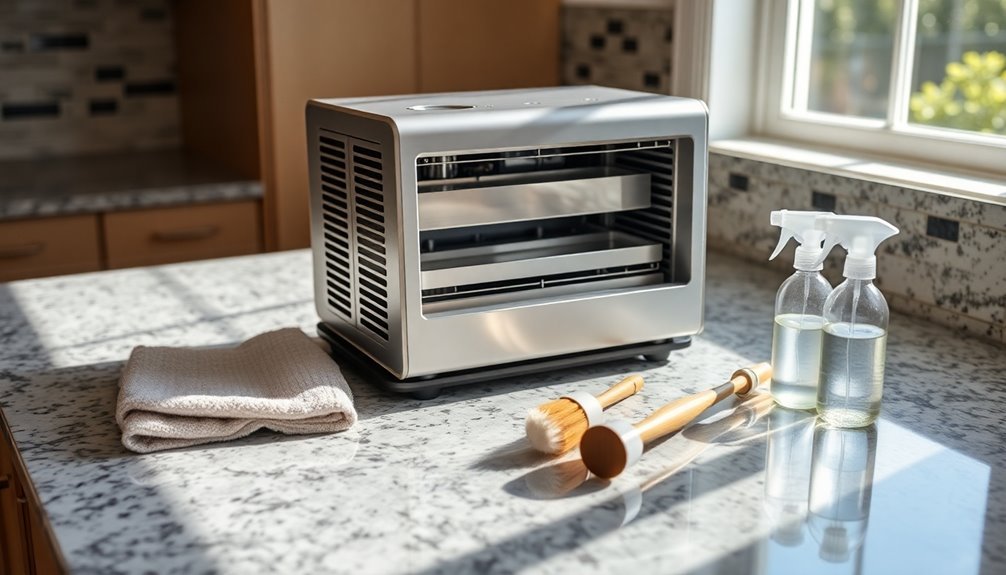To maintain your ionizer effectively, you'll need to focus on three essential practices. First, conduct regular testing with a Charged Plate Monitor (CPM) to verify that offset voltage stays below ±35 volts, starting one month after installation and monthly thereafter. Second, clean your ionizer properly by disconnecting power and using ESD-safe tools like IPA and soft cloths to remove dust from emitter pins and components. Third, create a smart maintenance schedule based on your specific environment and usage patterns. These fundamentals will set you up for peak ionizer performance, but there's more to explore for maximum efficiency.
Regular Testing and Verification

While maintaining ionizers may seem complex, regular testing and verification are vital components of an effective maintenance program. The trace gases and chemicals in cleanroom environments can still cause contamination despite having fewer ambient particles. According to industry recommendations, offset voltage limits should stay below ± 35 volts for proper compliance.
You'll need to conduct periodic testing using Charged Plate Monitors (CPMs) and Periodic Verification Systems (PVS) to guarantee your ionizers meet factory requirements and industry standards.
Start by testing your ionizers one month after installation to establish baseline performance. After that, you'll want to implement monthly testing intervals until you identify when performance begins to decline. This approach helps you determine the ideal maintenance schedule for your specific environment.
You should follow industry standards like ANSI/ESD STM3.1 and ANSI/ESD SP3.3 for proper testing procedures.
During testing, you'll measure two important factors: offset voltage and discharge time. Use your CPM to evaluate the ionizer's offset balance and measure how quickly it neutralizes static charges.
Don't forget to document all test results and maintenance activities – these records are essential for quality audits and justifying your calibration periods.
If you notice declining performance, clean and recalibrate your ionizers immediately to maintain peak functionality and compliance with industry standards.
Proper Cleaning Methods
Start with the fan filter by releasing the lock to access the housing. Clean the filter using an air gun, canned air, or water, ensuring it's completely dry before reassembly. Let the ionizer cool for 5 minutes if it was recently in operation. Don't forget to clean the filter housing while you're at it.
For the ionization fans and electrical components, remove dust using an ESD-safe vacuum or brush. When cleaning the emitter pins, use IPA and a cleanroom-safe swab, being careful not to damage these sharp components. Avoid harsh chemicals that could leave harmful residues.
After cleaning, reassemble all components securely and power up the ionizer. It's essential to verify the ion output balance and overall performance using a charged plate monitor or ionization test kit.
Make cleaning part of your regular maintenance schedule to maintain ideal ionizer function and extend its service life.
Smart Maintenance Scheduling

A well-planned maintenance schedule serves as the backbone of effective ionizer performance. While EIA-625 suggests checking ionizers every six months, you'll need to tailor your maintenance intervals to your specific environment and usage patterns.
Monitor your equipment's performance closely during the initial months to determine when cleaning becomes necessary – specifically, when ionizers no longer meet factory specifications.
To reduce maintenance burden, consider investing in self-cleaning ionizers with built-in brushes or automatic emitter point cleaning systems. These features can extend your maintenance intervals to annual checks.
You can further optimize your schedule by implementing continuous monitoring systems and regular power cycling. Remember to document all test results and adjust your maintenance plan accordingly.
This data-driven approach guarantees you're not over-or under-maintaining your equipment while maintaining compliance with ANSI/ESD S20.20 requirements.
Frequently Asked Questions
How Does Temperature Fluctuation Affect Ionizer Performance and Maintenance Requirements?
You'll notice temperature changes directly impact your ionizer's offset voltage and ion balance. You need more frequent calibration when temperatures fluctuate, as this affects static control efficiency and system stability.
Can Multiple Ionizers in Close Proximity Interfere With Each Other's Effectiveness?
Yes, if you place ionizers too close together, they'll interfere with each other's effectiveness. You'll notice reduced particle removal efficiency and compromised air quality. It's best to space them appropriately throughout your space.
What Safety Precautions Should Be Taken When Maintaining Ionizers in Humid Environments?
You'll need to disconnect power, guarantee proper grounding, use lint-free cloths with alcohol-based cleaners, avoid touching emitter pins, and let parts dry completely before reconnecting in humid conditions to prevent electrical hazards.
How Do Different Emitter Point Materials Impact Maintenance Frequency and Longevity?
You'll need more frequent maintenance with stainless steel emitters due to higher particle generation. Tungsten requires moderate upkeep, while single crystal silicon offers the longest maintenance intervals and best longevity.
When Should an Ionizer Be Replaced Rather Than Maintained?
You should replace your ionizer when you notice damaged emitter points, persistent performance issues, irreparable mechanical failures, or when maintenance costs exceed replacement value. Don't wait until it completely fails to upgrade.
In Summary
You'll maximize your ionizer's performance and longevity by following these three key maintenance practices. Test your unit regularly to verify it's working properly, clean components using manufacturer-approved methods, and stick to a consistent maintenance schedule. By implementing these essential tips, you're protecting your investment and ensuring your ionizer continues delivering clean, balanced air when you need it most.





Leave a Reply